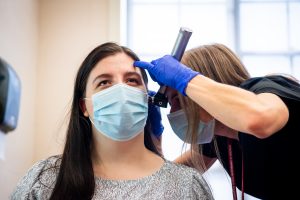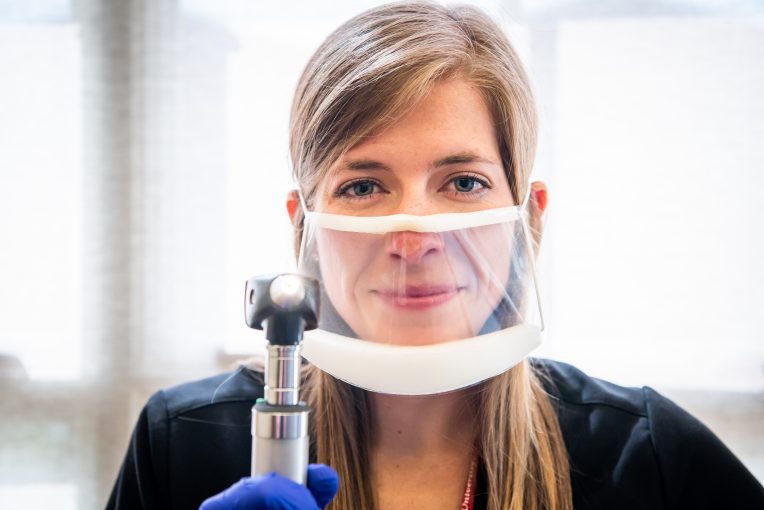It’s almost impossible to physically distance while making an impression of a patient’s ear for a hearing aid. The delicate work in the ear canal, so close to the ear drum, can also provoke a cough.
With coronavirus (COVID-19) restrictions, students cannot be within 6 feet of a patient for more than 15 minutes so they set a kitchen timer. When it ticks down to 3 minutes, the graduate student and the supervisor switch.
That’s one of the accommodations the Eckelmann-Taylor Speech and Hearing Clinic made to reopen to audiology patients in late June. In late August, it opened for speech therapy. Over the summer, teletherapy services were offered to patients over Zoom. Speech pathology graduate student Megan Rehn worked with patients virtually — and was grateful to have the experience while still in graduate school.
“Nobody knew what to expect going in but it was a really positive experience,” she said. “I’m glad we were able to get that at ISU. Having to figure it out when I had a supervisor was helpful.”
She works with patients one-on-one and in group settings. Groups no longer sit around tables working on activities, but instead are six feet apart in front of laptops.
“That’s been the biggest change,” Rehn said. “We do more conversation, problem-solving and communication skills through conversation. They’re used to wearing the masks and they’re used to all the regulations. They’re so happy to be here.”
The Communication Sciences and Disorders Department provides students with see-through masks, face shields, and gloves. Before entering the clinic, students and patients have their temperature taken and answer health screening questions.
“They have rolled with every single change. They are very appreciative for the clinicals. They’re doing everything they can to stay safe so they can see patients.” — Cara Boester
Cara Boester, director of clinical education-speech language pathology, said the clear masks provided by the department, which allow patients to see the student’s face, are working well.
“The clear masks that we’ve received for the speech side have been amazing,” she said. “They don’t fog up, and you can see really well.”
Ninety percent of the clinic couldn’t be used because rooms were too small. It expanded into nearby classrooms and even then, only two people can be in the room with the patient. Students have adapted well, Boester said.
“They have rolled with every single change. They are very appreciative for the clinicals. They’re doing everything they can to stay safe so they can see patients.”

When physical distancing isn’t possible, a kitchen timer is set so a student spends no more than 15 minutes with a patient before another provider steps in.
And, many speech patients still opt for teletherapy, she added.
“Teletherapy is a great option. Some people don’t want to come in, some do want to come in.”
Speech pathology students are seeing fewer pediatric patients in person because they must be able to wear a mask for an hour and physically distance – difficult for preschoolers, but there’s a 4-year-old patient who is doing well.
“It can be done,” Boester said. “We had a pediatric patient on teletherapy and moved them to in person. We’re trying to be flexible in providing the best service we can.”
Dr. Candice Osenga, director of clinical experiences-audiology, said it works a little different on the audiology side because children as young as 6 months old who are having hearing tests can sit on a parent’s lap in a booth while clinicians are on the other side.
Having the clinic open again benefits older adults who need hearing aid adjustments or reprogramming. Although that’s offered through teletherapy, it requires an internet connection, Bluetooth capability, and a comfort level with technology.
“A lot of things have to line up,” Osenga said.
The clinic is still seeing the same number of patients, and has also reopened its satellite office in Normal Township’s Activities and Recreation Center.
Marysue Cicciarelli, a graduate student in audiology, works with adults who need hearing assessments, hearing aid adjustments, or have issues such as tinnitus, or chronic ringing in the ear. If a patient depends on lip reading, she’ll pull on a clear mask. There’s also a Plexiglas divider between her and the patient.
“That’s worked well,” she said.
She’s grateful to faculty who found creative ways to continue offering instruction after the stay-at-home order went into effect last March.
“They gave us case studies to still be able to learn. We did a lot of role playing through Zoom on how to counsel patients. When we did get back to the clinic, we were so happy.”
She added she appreciates the concern faculty has shown for students’ health and safety.
“Our clinical educators made it clear that if you have concerns about being here, let them know and they will work with you. They told us to do what we need to do to be safe.”
Apply now for fall 2021.

